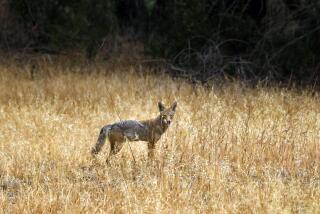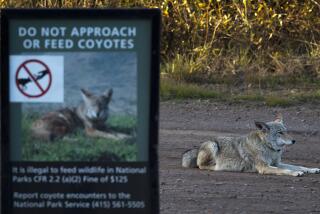Suspects Considered Wily if Not Dangerous
- Share via
Just when you thought it was safe to sit in a Jacuzzi, fetch the morning newspaper or simply carry a purse, along comes a new breed of animal outlaw.
Coyotes have long been notorious for chomping on small pets and children, but in recent years they’ve detoured into more esoteric realms, such as foot fetishes, purse snatchings and nouvelle cuisine.
Saturday night, as 27-year-old Kyle Stone soaked in a hot tub at Irvine’s Quail Meadows apartment complex, he felt a stinging pain on his head. Spinning around, he discovered his assailant was a coyote, which quickly scampered away, police said.
Authorities believe the four-legged intruder “may have mistaken the resident’s head for a food source,” Irvine Police Lt. Rick Handfield said.
And, no, the victim wasn’t wearing a fluffy toupee or meat-scented hair gel, said Handfield, who has been fielding odd questions from the media, including whether Stone had “tabby-colored hair.”
Close encounters of the coyote kind have taken some strange turns over the years. The trend dates to at least 1947, when a pair of coyotes at Yellowstone National Park grew so accustomed to tourists that the animals were “extensively observed begging for food and posing for pictures,” according to a 2004 UC Davis study on coyote attacks. Before that, park visitors were “lucky to even see a glimpse” of a coyote.
A similar pattern has evolved in Southern California. As housing tracts encroach on wilderness, some coyotes lose their natural fear of humans. A “wildlife-loving general public” that rarely confronts coyote visitors has also emboldened the animals, UC Davis researchers concluded.
Clashes with the varmints have soared over the last decade, said Steve Martarano, a spokesman with the state Department of Fish and Game.
In San Juan Capistrano nine years ago, coyotes charged two women and took their purses, according to the UC Davis report.
A year earlier, at a Pavilions grocery store in Laguna Niguel, a coyote brazenly strolled through the automatic doors, padded down Aisle 6 past the canned fruit, browsed the magazine section and vaulted over the meat counter, according to the Orange County Register.
“I’ve been in the grocery business 30 years and I’ve never had a coyote come in the store,” the manager told the paper.
Some urban coyotes appear to have developed a fixation on human feet.
In 1995, a shoeless Laguna Niguel man was munched on the foot while star gazing from a chaise lounge, according to the UC Davis study. That same year, another barefoot Laguna Niguel resident was nibbled while retrieving a newspaper from the lawn.
The newspaper incident was one of at least two journalism-related coyote assaults on record. In 1979, a Pasadena man was bitten on the heel while picking up his newspaper.
In 1988, an 8-year-old girl in Oceanside fell while roller skating and a coyote started tugging at her skate, the UC Davis report said.
More recently, the animals have been eyeing the opposite end of the body. In 2001, a camp counselor sleeping in the Kern County town of Frazier Park woke up to find a coyote sniffing and pawing at her noggin.
In the wake of Saturday’s hot tub ambush, which left a small puncture or scratch on the victim’s scalp, officials posted fliers and scoured the neighborhood for a suspect described as about 2 feet tall with pointy ears, an elongated snout and a bushy, black-tipped tail.
A break came Monday night, when Fish and Game wardens captured two coyotes in the area.
Alas, there won’t be a police lineup to see whether the victim can identify his alleged assailant. If police had taken a DNA swab from the scalp wound, they could’ve tested the coyotes, Handfield said. But either way, the animals would be doomed.
Aggressive coyotes receive frontier justice. They were “removed from the population,” Handfield explained diplomatically, noting that relocating outlaw coyotes doesn’t work.
As Mark Twain once observed, coyotes are “always poor, out of luck and friendless.”
More to Read
Sign up for Essential California
The most important California stories and recommendations in your inbox every morning.
You may occasionally receive promotional content from the Los Angeles Times.










